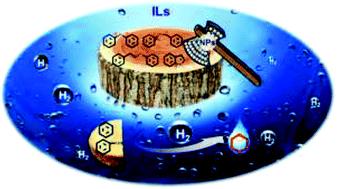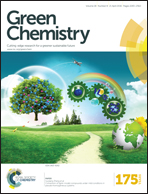Conversion of lignin model compounds under mild conditions in pseudo-homogeneous systems†
Abstract
To produce basic chemicals from lignin, depolymerization and removal of oxygen from lignin through C–O cleavage and hydrodeoxygenation (HDO) are crucial steps. In this study, a novel, pseudo-homogeneous catalyst system, consisting of uniformly stabilized noble metal nanoparticles (NPs) in ionic liquids is developed for the selective reductive cleavage of C–O and HDO. Phenol and guaiacol as lignin monomer model compounds are investigated to gain an insight into the possible HDO pathway, meanwhile, dimeric model compounds such as diphenyl ether and benzyl phenyl ether are studied for the cleavage of C–O bonds between aromatic units. Four types of NPs including Pd, Pt, Rh and Ru were synthesized in situ and well distributed in ILs without aggregation. These catalytic systems displayed almost 100% conversion for various monomeric and dimeric lignin model compounds at 130 °C and were recycled several times without loss of activity. The catalytic selectivity of metals for HDO/C–O cleavage normally decreases in the order of Pt > Rh ∼ Ru ≫ Pd, which is similar to the order of NP size, Pd ≫ Pt > Rh ∼ Ru. With a mean diameter of 5.6 nm, Pt NPs in [Bmim]PF6 are identified as the best catalytic system for the transformation of lignin monomeric and dimeric model compounds with an almost 100% conversion and maximum 97% selectivity.


 Please wait while we load your content...
Please wait while we load your content...